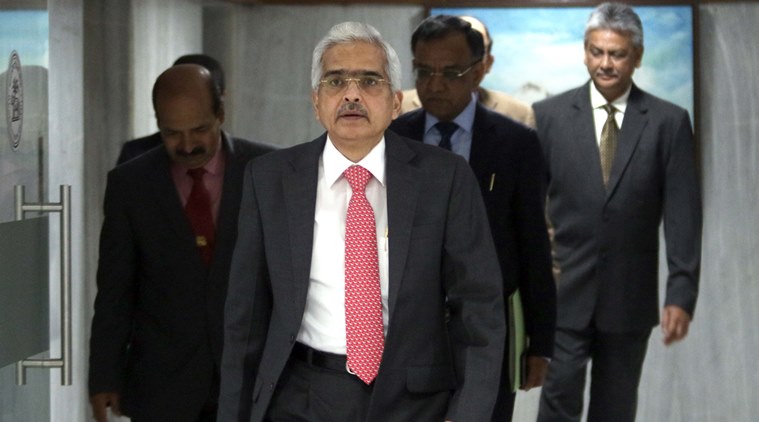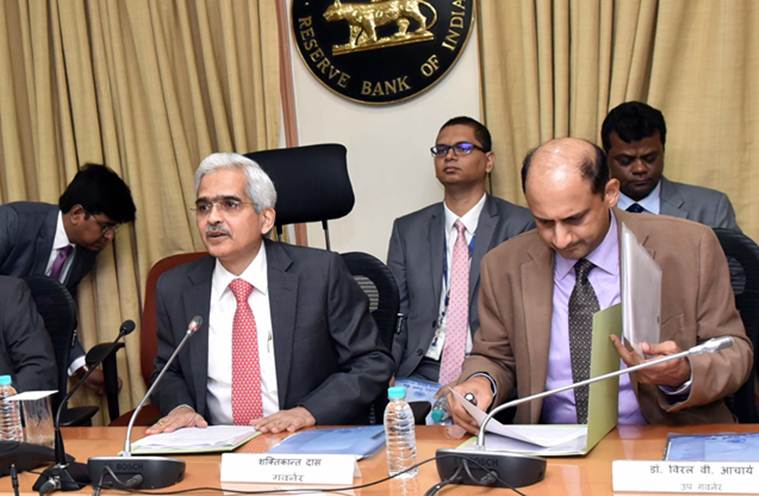This is the third such rate cut of 25 basis points in calendar year 2019. With this, the RBI’s main policy rate now stands at a level touched almost nine years ago in July 2010.
To revive consumer demand and give growth a fillip, the Reserve Bank of India Thursday reduced the repo rate — the rate at which banks borrow from the central bank — by 25 basis points to 5.75 per cent. Banks are expected to pass on the benefits of lower interest rates to the corporate sector and individual consumers in coming months.
The RBI simultaneously changed its monetary policy stance to “accommodative” from “neutral” stating “there is scope to accommodate growth concerns and reinvigorate private investment activity”. Private investment, according to latest GDP data, had sequentially slowed down in the last three quarters in 2018-19.
This is the third such rate cut of 25 basis points in calendar year 2019. With this, the RBI’s main policy rate now stands at a level touched almost nine years ago in July 2010. The decision of the RBI Monetary Policy Committee (MPC), chaired by Governor Shaktikanta Das, was unanimous with the committee voting 6-0 in favour of a rate cut as well as change in policy stance to “accommodative”.
The rate cut, however, failed to enthuse the stock markets with the Bombay Stock Exchange Sensitive Index (Sensex) falling 554 points during the day. The drop was attributed to the growing concern over the NBFC liquidity crisis, which the RBI did not specifically address in this policy.
Das said he was hopeful of “higher and faster transmission” of the repo rate cut to bank customers. Transmission of the cumulative reduction of 50 bps in the policy repo rate in February and April 2019 was 21 bps to the weighted average lending rate (WALR) on fresh rupee loans. “Accommodative stance means a rate hike is now off the table. The unanimous vote reflects the resolve of the MPC to act decisively and act in time,” Das said after unveiling the second bi-monthly monetary policy statement for 2019-20.
Explained | Why RBI has cut lending rates for the third consecutive time
According to analysts tracking the RBI policies, the change in stance to “accommodative” has happened only twice in the last 20 years — first after the dotcom bubble and global slowdown in 2002-03 period and then later after the Lehman crisis in 2008-09. “The RBI policy decision to change the policy stance to ‘accommodative’ will simultaneously help the financial system to navigate to a lower term structure of interest rates and also accommodate growth concerns,” said SBI Chairman Rajnish Kumar.
The central bank lowered its growth forecast to 7 percent for 2019-20 from the April view of 7.2 per cent. The fiscal year 2019 ended with a lower than estimated 6.8 per cent growth as the fourth quarter GDP printed a five-year low of 5.8 per cent. The MPC said growth impulses have weakened significantly as reflected in a further widening of the output gap compared to the April 2019 policy. A sharp slowdown in investment activity along with a continuing moderation in private consumption growth is a matter of concern, the MPC said.
According to Das, the MPC took note of the fact that retail retail inflation remained unchanged in April from its March level of 2.9 per cent. Higher inflation in food and fuel groups was offset by lower inflation in items excluding food and fuel. Inflation expectations of households in the May 2019 round of Reserve Bank’s survey declined by 20 basis points for the three-month ahead horizon compared with the previous round but remained unchanged for the one-year ahead horizon.
Opens window for another cut
With the fiscal policy remaining constrained, and inflation forecast benign, the RBI’s ‘accommodative’ stance reflects the imperative of the monetary policy to foster growth. A mere 25 bps cut this time opens up the possibility of another rate cut if the monsoon progresses favourably and the government sticks to its fiscal consolidation path.
However, the RBI marginally raised its retail inflation outlook for the first half of fiscal 2019-20 to a range of 3-3.1 per cent from a range of 2.9-3 per cent it had forecast in April. The central bank slashed its inflation outlook for the second half of the year to 3.4-3.7 per cent from its earlier projection of 3.5-3.8 per cent. “The headline inflation trajectory remains below the target mandated to the MPC even after taking into account the expected transmission of the past two policy rate cuts,” the MPC said.
On the fiscal front, the government has broadly followed the fiscal glide path and is likely to stay fiscally prudent, Das said at the press conference. “This essentially means that unless there is a significant change in the fiscal deficit numbers for FY20 (compared to the interim budget), there could be room for the RBI to support growth through further interest rate cuts,” said Abheek Barua, Chief Economist, HDFC Bank.
Editorial | RBI cuts rates, but its impact on economic activity depends on banks transmitting it to borrowers
Regarding liquidity, Das said RBI will ensure that “adequate liquidity is available in the system for all productive purposes”. “We have been closely monitoring the performance and developments in the NBFC and HFC sectors. The RBI will not hesitate to take any measure to ensure financial stability in the sector,” he said on the liquidity crisis in the NBFC sector.
The MPC noted that global economic activity is losing pace and there is slowdown both in advanced as well emerging economies. Crude oil remains volatile and the financial markets are driven by uncertainty surrounding US-China trade negotiations and Brexit. Further, domestic economic activity has slowed down with GDP growth declining to 5.8 per cent in the fourth quarter of 2018-19. High frequency indicators like vehicle sales, cement sales, freight and air traffic growth have further shown slowdown.
Retail inflation, excluding food and fuel, fell sharply to 4.5 per cent in April from 5.1 per cent in March – the largest monthly decline since April 2017. The moderation in inflation was broad-based, with household goods and services, and personal care and effects sub-groups registering the largest fall in April. “Depending on how the risks to inflation pan out, the RBI could cut interest rates further or stay on hold – the two possible options in an accommodative phase. Moreover, the focus is likely to be on the transmission by keeping ample liquidity (possibly surplus on some of the days) in the banking system,” Barua said.
Source: Read Full Article



